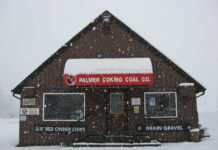Coal mining was an up and down industry. Booming one year and bust the next. This 1909 photo shows the abandoned 3,000-ton bunker of the Issaquah Coal Company about five years after production stopped. Coal mining came to Issaquah early. The area was first known as Squak, the name used by native tribes that referred to the calls and squawks of the various birds which frequented the bogs, swamps, and creeks of the valley.
The area around Squak Mountain lays claim to some of the first coal mined in King County. Two settlers, Lyman B. Andrews and David Mowery discovered coal there in 1859. Three years later Andrews carried a sack of that coal to the blacksmith shop of W.W. Perkins in Seattle. It tested so well that Andrews and Perkins formed a working partnership and mined 350 tons that winter. However, transportation costs to Seattle, without a viable railroad, were too high so little became of their efforts. It wasn’t until the building of the Seattle, Lakeshore, and Eastern railroad in 1885-86 that made practical the reopening of the Gilman mines by the Seattle Coal & Iron Co. The town was briefly known as Gilman for one of the men responsible for bringing rail service to the area. By 1889, the mines employed 225 miners.
In 1891, labor disputes struck the Gilman mines and the National Guard was called out to restore peace. Still, the mines proved productive and during their first 17 years over 1.5 million tons of coal were mined and shipped to market. Then on June 27,1904 a strike was called by Issaquah miners, followed by a fire in October. The pumps were withdrawn from the mine and by the time of this photo five years later, the operation stood practically abandoned. This image by E. Eggleston Smith appeared in 1911 in the U.S.G.S. Bulletin #474, the “Coals of the State of Washington.”






